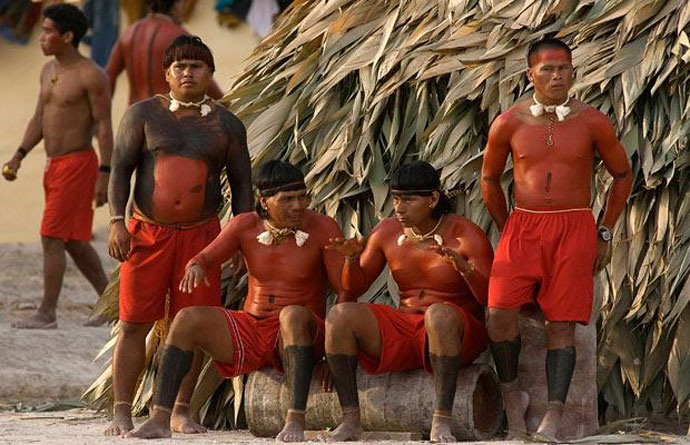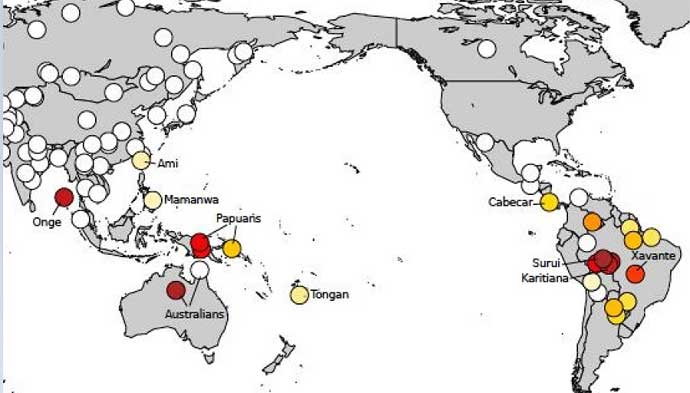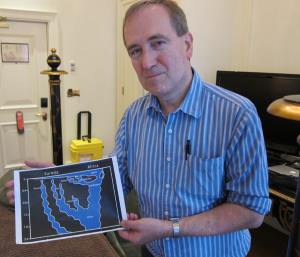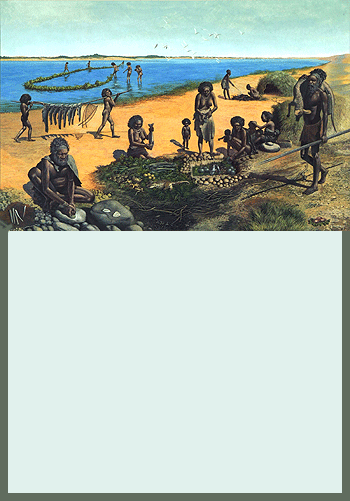Evidence that 'Australian' First Nations peoples were the first Americans? Tribes in the Amazon found to be the most closely related
BBC Documentary follows recent research, including the Baja California study, indicates that the initial settlement of the continent was instead driven by Southeast Asians who occupied Australia expanded into the Americas about 13,500 years ago, prior to Mongoloid people arriving from northeast Asia.
This is not consistent with Western Science's 'Out of Africa' theory as it stands today, but First Nations cultural stories tell us that we have always been on this continent which Western science disregards, whereas their 'Out of Africa' theory is far from being rock-solid and keeps getting modified every few months.

Genetic evidence for two founding populations of the Americas PDF
Pontus Skoglund, Swapan Mallick, Maria Catira Bortolini, Niru Chennagiri, Tabita Hunemeier,
Maria Luiza Petzl-Erler, Francisco Mauro Salzano, Nick Patterson & David Reich
Richard Gray Daily Mail (Mainline) UK 23 July 2015 [Edited]
It was a continent thought to have been uninhabited by humans until around 15,000 years ago when the 'First Americans' came across a tiny strip of land over the Bering Strait.
A new genetic study, however, is threatening to transform theories about who the original Native Americans were after finding certain tribes in the Amazon are related to Aborigines in Australia.


"Christopher Stringer is one of the world's foremost paleoanthropologists. He was a founder and most powerful advocate of the leading theory concerning the evolution of modern man: Recent African Origin or 'Out of Africa.' He now calls the theory into question: 'I'm thinking a lot about species concepts as applied to humans, about the "Out of Africa" model, and also looking back into Africa itself.
I think the idea that modern humans originated in Africa is still a sound concept. Behaviorally and physically, we began our story there, but I've come around to thinking that it wasn't a simple origin. Twenty years ago, I would have argued that our species evolved in one place, maybe in East Africa or South Africa.
There was a period of time in just one place where a small population of humans became modern, physically and behaviourally. Isolated and perhaps stressed by climate change, this drove a rapid and punctuational origin for our species. Now I don't think it was that simple, either within or outside of Africa.'" - Source: https://goo.gl/NZ9OyX
Christopher Stringer studied anthropology at University College London, and holds a PhD in Anatomical Science, and a DSc in Anatomical Science
The findings suggest America may have actually experienced multiple waves of migration thousands of years ago, rather than just one that spread down through the continent from the north.
Researchers found people belonging to the Suruí, Karitiana and Xavante peoples in the Amazon are more closely related to indigenous populations in Australasia than any other modern group.
Australian Aborigines, together with indigenous populations in New Guinea and the Andaman Islands, were thought by western scientists to be descended from one of the earliest groups of modern humans to migrate out of Africa around 60,000 years ago. However this theory has been debunked in recent years.
Oral folklore tells how the Great Barrier Reef once formed part of the coastline of north east Queensland, while Port Phillip Bay in Victoria was once a rich place for hunting kangaroo and opossum.
Researchers have found other stories from all over the continent that mirror how the landscape dramatically changed towards the end of the last ice age.
They say at this time sea levels rose as a result of the melting of the huge ice caps that covered much of the northern hemisphere around 10,500 years ago.
They are thought to have been a sea faring people who were able to hop between the islands that extend from Asia to Australia.

Native South Americans in Brazil by Giulio Ferrario, 1823-1838
The new findings suggest their descendants may have ranged far further and could have crossed the vast ocean expanse between Australia and south America.
However, the researchers say they could have also travelled across ice sheets to the north.
Professor David Reich, a geneticist at Harvard Medical School who led the study, said: 'It's incredibly surprising.
'There's a strong working model in archaeology and genetics, of which I have been a proponent, that most Native Americans today extend from a single pulse of expansion south of the ice sheets—and that's wrong.
'We missed something very important in the original data.
'About 2 per cent of the ancestry of Amazonians today comes from this Australasian lineage that's not present in the same way elsewhere in the Americas.'
The researchers, whose work is published in the journal Nature, analysed the DNA from 21 Native American populations in Central and South America.

An indigenous Xavante midwife
(Agência Brasil)
They also collected and analysed DNA from nine populations in Brazil before comparing it to the genomes of people from 200 non-American populations.
They found the Tupí-speaking Suruí people who first came into contact with the modern world in 1969, the Karitiana tribe, who live in western Amazon, and the Ge-speaking Xavante people in Eastern Brazil, all had genetic links to indigenous Australians.
Native Brazilian people like the Xavante (above) may owe much of their origins to the ancestors of Aborigines in Australasia. Two other tribes, the Suruí and the Karitiana, were also found to have a similar genetic ancestry
However, the scientists could not find any other traces in other Native American groups in South, Central or North America.

Not Africa!
The one dimensional western scientific analogy together with archaeological findings are slowly moving the narrative closer to our stories of 'The Dreaming', which tell us we have always been on this continent. MORE
The researchers say the genetic signals do not match any population known to have contributed to Native American ancestry and the geographic pattern cannot be explained by post-colonial European, African or Polynesian mixture with Native Americans.
Instead they believe the genetic link may be as old as the first human populations to colonise the continent.
It raises the prospect that the Aborigine populations may even have been living in the area before Native Americans arrived.
Australian Aborigines, like those pictured above, are thought to be descended from one of the earliest groups of modern humans to migrate out of Africa. It seems as well as colonising Australasia, they also extended as far away as South America, leaving a their mark in the DNA of native people living in the Amazon today
Australian Aborigines, like those pictured above, are thought to be descended from one of the earliest groups of modern humans to migrate out of Africa. It seems as well as colonising Australasia, they also extended as far away as South America, leaving a their mark in the DNA of native people living in the Amazon today
The researchers say their findings echo suggestions that skeletons of early Native Americans found in Brazil have skulls that have Australasian features.
The researchers have now named the mystery ancestors as Population Y after the after the Tupí word for ancestor, 'Ypykuéra'.
Dr Pontus Skoglund a geneticist at Harvard Medical School who was part of the team, said: 'We don't know the order, the time separation or the geographical patterns.
'We've done a lot of sampling in East Asia and nobody looks like this. It's an unknown group that doesn't exist anymore.
'It suggests there was a greater diversity of the founding populations of the Americas than was previously thought. It was previously completely unknown.'
Genetic evidence for two founding populations of the Americas PDF
Pontus Skoglund, Swapan Mallick, Maria Catira Bortolini, Niru Chennagiri, Tabita Hunemeier,
Maria Luiza Petzl-Erler, Francisco Mauro Salzano, Nick Patterson & David Reich
Who were the first Americans? Where did they come from? When did they first arrive here? This BBC documentary answers those questions. Scientist were stunned to find evidence of civilization in Brazil dating to around 50,000 years ago. Evidence of fire usage, rock art paintings, and some of the oldest skeletal remains ever found in the America's have established a new timeline for the arrival of modern humans in the America's. Analysis on skulls found show that they are more similar to the bone structure of Africans and Australian Aborigines.
Another study conducted by researchers at the University of Copenhagen was published in the Science magazine. Danish scientists also found links between Australasian DNA and that of Amazonian tribes. However, this study argues that the Australasian DNA came to the Americas 9,000 years ago rather than 15,000 years claimed by the Harvard study.
Vikas Shukla, Value Walk - Science 22 July 2015
Scientists have discovered distant DNA links between Aboriginal Australians and tribes living deep within the Brazilian Amazon.com, Inc. (NASDAQ:AMZN) rainforest. Two different groups of researchers who conducted genetic analyses established that people sharing DNA links with indigenous Australians cross the Bering land bridge between Siberia and the Americas thousands of years ago.
Australians Amazonians
Population Y carried ancestry related to indigenous Australians
One study led by David Reich of Harvard University was published in the journal Nature. David Reich and his colleagues concluded that there could have been multiple migrations from Siberia to the Americas. They said the first migration from Siberia that occurred about 15,000 years ago consisted of two different groups: the First Americans and Population Y. Researchers said the Population Y could have arrived before, after or around the same time as First Americans.
David Reich concluded that Population Y "carried ancestry more closely related to indigenous Australians, New Guineans and Andaman Islanders than to any present-day Eurasians or Native Americans.” The term 'Population Y' is derived from Ypykuéra, which means ancestor in the Tupi language spoken by two Amazonian tribes, the Karitiana and Surui.
These tribes show strong connections to Australasians. However, Reich stressed that there was no "unmixed population" related to Australasians that came to the Americas. He said the Population Y contributed Australasian genes to the Amazonian tribes. This group was mixed with a Native American lineage by the time it reached the Amazon. Harvard scientists said about 85% ancestry in Amazonian tribes came from the Population Y, while just 1-2% came from Australasians.
Danish group disagrees on timing
Another study conducted by researchers at the University of Copenhagen was published in the Science magazine. Danish scientists also found links between Australasian DNA and that of Amazonian tribes. However, this study argues that the Australasian DNA came to the Americas 9,000 years ago rather than 15,000 years claimed by the Harvard study.
The Danish study concluded that Australasian DNA reached the Americas via Aleutian Islanders, who also carried DNA characteristics of Aboriginal Australians.

